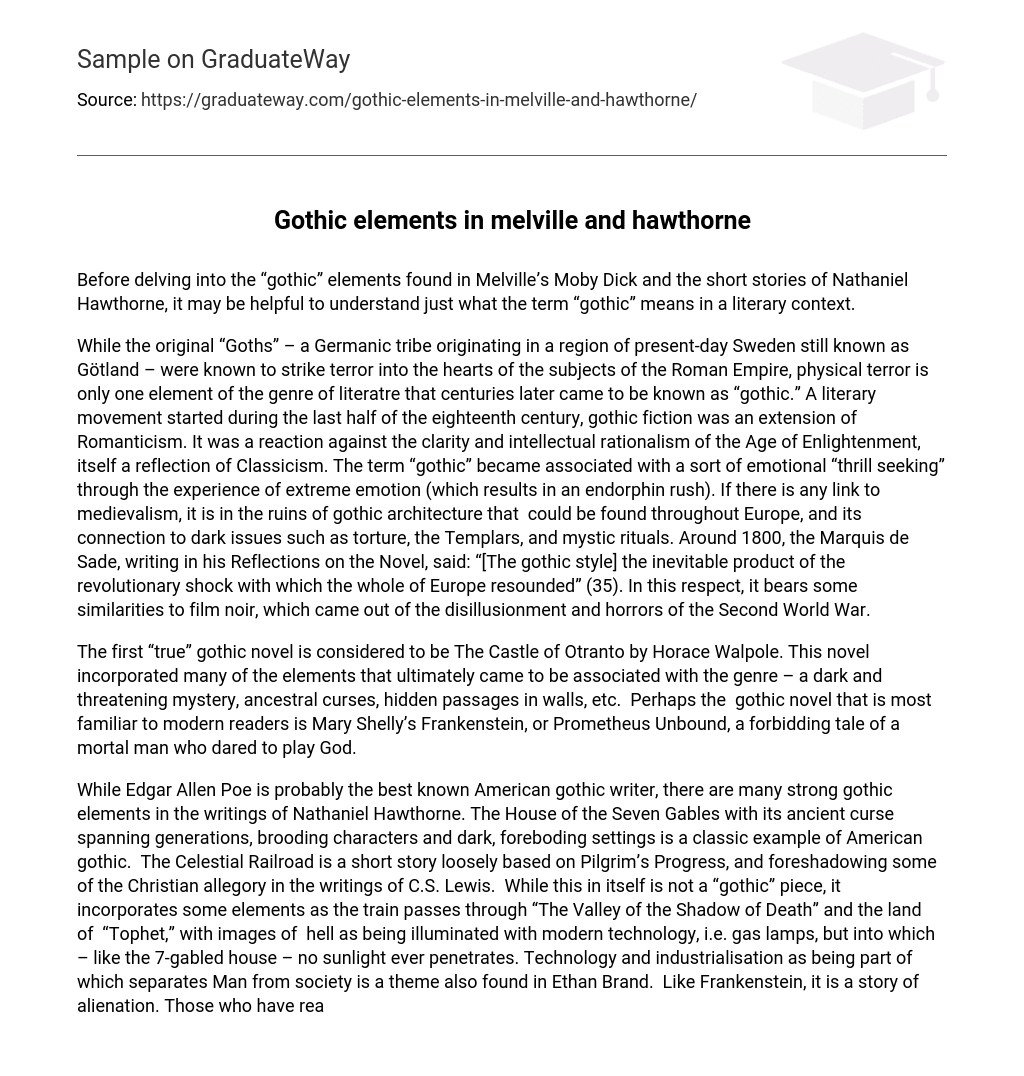Before delving into the “gothic” elements found in Melville’s Moby Dick and the short stories of Nathaniel Hawthorne, it may be helpful to understand just what the term “gothic” means in a literary context.
While the original “Goths” – a Germanic tribe originating in a region of present-day Sweden still known as Götland – were known to strike terror into the hearts of the subjects of the Roman Empire, physical terror is only one element of the genre of literatre that centuries later came to be known as “gothic.” A literary movement started during the last half of the eighteenth century, gothic fiction was an extension of Romanticism. It was a reaction against the clarity and intellectual rationalism of the Age of Enlightenment, itself a reflection of Classicism. The term “gothic” became associated with a sort of emotional “thrill seeking” through the experience of extreme emotion (which results in an endorphin rush). If there is any link to medievalism, it is in the ruins of gothic architecture that could be found throughout Europe, and its connection to dark issues such as torture, the Templars, and mystic rituals. Around 1800, the Marquis de Sade, writing in his Reflections on the Novel, said: “[The gothic style] the inevitable product of the revolutionary shock with which the whole of Europe resounded” (35). In this respect, it bears some similarities to film noir, which came out of the disillusionment and horrors of the Second World War.
The first “true” gothic novel is considered to be The Castle of Otranto by Horace Walpole. This novel incorporated many of the elements that ultimately came to be associated with the genre – a dark and threatening mystery, ancestral curses, hidden passages in walls, etc. Perhaps the gothic novel that is most familiar to modern readers is Mary Shelly’s Frankenstein, or Prometheus Unbound, a forbidding tale of a mortal man who dared to play God.
While Edgar Allen Poe is probably the best known American gothic writer, there are many strong gothic elements in the writings of Nathaniel Hawthorne. The House of the Seven Gables with its ancient curse spanning generations, brooding characters and dark, foreboding settings is a classic example of American gothic. The Celestial Railroad is a short story loosely based on Pilgrim’s Progress, and foreshadowing some of the Christian allegory in the writings of C.S. Lewis. While this in itself is not a “gothic” piece, it incorporates some elements as the train passes through “The Valley of the Shadow of Death” and the land of “Tophet,” with images of hell as being illuminated with modern technology, i.e. gas lamps, but into which – like the 7-gabled house – no sunlight ever penetrates. Technology and industrialisation as being part of which separates Man from society is a theme also found in Ethan Brand. Like Frankenstein, it is a story of alienation. Those who have read Shelly’s original will recall that the “monster,” initially a creature of great beauty, intelligence and sensitivity, was outcast as his origins became known and his physical appearance began to deteriorate; the dehumanization of the industrial age is a common theme of gothic literature. Earth’s Holocaust is yet another metaphor, depicting what Hawthorne considers to be the transitory nature of life and the things that people hold on to; musty treasures representing pomp, rank and ostentation from old Europe from the past are burned in a huge bonfire. Less “gothic” than Seven Gables (which is a true gothic work), Earth’s Holocaust seems to be metaphorical of the American ideal itself, in which no man may claim superiority on account of the deeds of his ancestors, but must rather earn it through his own good character. Perhaps the burning of old treasures could be considered a type of “gothic” imagery.
Moby Dick, Herman Melville’s best-known work, is “gothic” in the sense that it takes us (once it gets past the seemingly endless litany on methods of 19th-Century whale hunting) into the darkest places of a man’s soul. The metaphor and foreshadowing of these places appears at the very beginning:
“…whenever it is a damp, drizzly November in my soul;
whenever I find myself involuntarily pausing before coffin warehouses,
and bringing up the rear of every funeral I meet; and especially whenever
my hypos get such an upper hand of me, that it requires a strong moral principle
to prevent me from deliberately stepping into the street, and methodically
knocking people’s hats off—then, I account it high time to get to sea as
soon as I can.”
Apparently, Ishmael understands his own dark tendencies all too well.
Ahab is a man obsessed with revenge; revenge for the loss of his leg to the great white whale whom he must destroy, or die in the attempt. His language is that of high melodrama: “to the last I grapple with thee; from hell’s heart I stab at thee; for hate’s sake I spit my last breath at thee” (565). Images of death and foreboding abound; the ship is compared to a hearse; the sound of Ahab’s wooden leg is likened unto a “coffin-tap” (231); in an ironic twist, Ishmael – the character from whose perspective we read the tale – is saved at the end by grasping on to a floating coffin (“Coffin” is the name of numerous characters in the book, and seems to be a significant industry in the Pequod’s home port).
Gothic literature has been the forerunner of modern horror that began with Bram Stoker and H.P. Lovecraft, and continues in the better writings of Anne Rice and Steven King; ultimately, however, it is not about the darkness without, but that within us.
Work Cited
Melville, Herman. Moby Dick, or The Whale. (New York: Hendricks House, 1952)
Seaver, Richard, ed. The 120 Days of Sodom. (New York: Grove Press, 1996)





